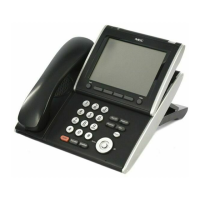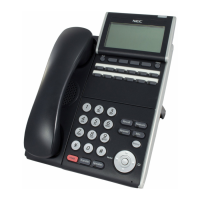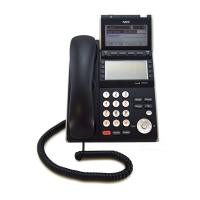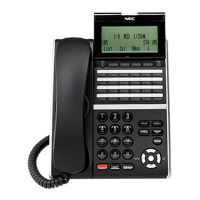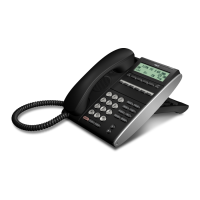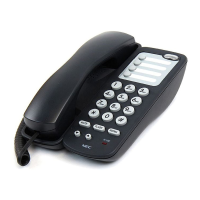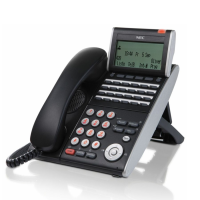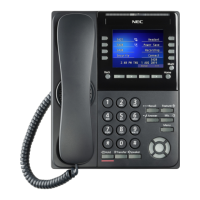Do you have a question about the NEC DT710 and is the answer not in the manual?
Displays the physical layout and key functions of the UNIVERGE DT730/DT710/DT330/DT310 terminals.
Identifies and describes the various keys and components of the DT310/DT710 telephone.
Notes specific terminal settings that are not applicable to the DT700 Series phones.
Provides instructions on how to adjust the tilt leg of the telephone set to four different levels.
Details the steps for removing and attaching the tilt leg assembly to the telephone base.
Explains how to connect the line cord to the telephone set, routing it through the groove.
Guides the user through the process of attaching a directory card holder and card to the telephone.
Details how to connect the handset coiled cord to the telephone, routing it through the groove.
Provides instructions for removing and installing the key set unit or button panel on the telephone.
Explains how to mount the telephone set on a wall using a wall mount unit, including necessary procedures and warnings.
Describes how to adjust handset volume, speaker volume, ringer tone, and LCD contrast using the UP/DOWN keys.
Explains how to use the Feature key for microphone control, volume adjustment, and ringer tone selection.
Details how to configure terminal settings like off-hook ringing using the Menu key on DT700 Series phones.
Provides steps to change the existing password for phone locking, directory data deletion, or settings reset.
Details the procedure for clearing personal data and resetting telephone settings to default.
Explains how to download files for Music on Hold, Ringer Tone, and Directory using an FTP/TFTP server.
Describes the steps for logging into and out of the DT700 Series terminal.
Explains how to originate outside and internal calls, and manage multiline appearance.
Details procedures for placing calls on hold, retrieving held calls, and using exclusive hold.
Provides instructions on how to transfer a call to another station, including procedures for unanswered calls.
Explains character entry modes (uppercase, lowercase, numeric) and using the sub-menu for text input.
Displays character code lists for English, showing digit key mappings for various characters.
Demonstrates character entry by showing how to type specific names like "Ko Abe" using the phone's interface.
Explains how to overwrite existing characters with new text using the phone's input interface.
Details the process of copying and pasting characters within the phone's text input fields using the sub-menu.
Explains how to lock and unlock the telephone using the Security key, including password entry and security lamp indications.
Describes how to originate calls using One-Touch Speed Calling keys, including programming and verification.
Explains how to originate calls using speed calling for station/group numbers and system-wide speed calling.
Details procedures for entering account, authorization, and forced account codes for call management.
Explains how to initiate and answer voice calls, including hands-free operation using soft keys.
Guides users on initiating, answering, and bridging into automatic intercom calls.
Explains how to initiate, answer, and bridge into manual intercom calls.
Details the process for initiating, answering, and bridging into dial intercom calls.
Describes how to establish three-way conferences and broker calls, including answering camped-on calls.
Explains how to program, activate, and use call waiting when originating calls, including answering waiting calls.
Details how to program call park keys, park calls, and retrieve parked calls from originating or remote stations.
Guides users on programming and using call pick-up features for both group and direct station rings.
Explains procedures for outgoing and off-hook trunk queuing, and how to perform an executive override.
Details how to recall the last number dialed and set up call forwarding for all calls.
Guides users on setting, verifying, and cancelling call forwarding when the line is busy.
Explains how to set, verify, and cancel call forwarding when the called station does not answer.
Covers call destination settings for logged-out IP stations and how to enable/disable the privacy feature.
Describes how to release privacy, allowing another station to enter an ongoing conversation.
Explains how to originate calls from the system phonebook and register/manage entries in the local phonebook.
Guides on registering names and telephone numbers into the local phonebook, including adding company names and ring tones.
Explains how to add a prefix to a telephone number stored in the local phonebook.
Details the process for changing the name of a group within the directory settings.
Guides on searching for registered data in the directory by group name.
Explains how to search the directory for entries by name, including character entry and search tips.
Details how to search the directory for entries by telephone number, including tips for partial entries.
Explains how to search the directory using a memory ID, including entering the memory number and finding details.
Guides on searching the directory by category, selecting a category, and displaying applicable names.
Details how to search the directory for entries by company name, including character entry and search tips.
Explains how to search the directory by alphabet, selecting a group of letters and displaying applicable names.
Provides step-by-step instructions for making calls from the directory, covering both detailed data and name lists.
Details how to set prefixes for dialing numbers, including setting up prefixes 1, 2, and 3.
Guides on editing existing directory data, including modifying name, group, and other details.
Explains how to delete all registered data from the directory, including confirmation and cancellation procedures.
Details how to delete a specific entry from the directory, including confirmation and cancellation.
Introduces directory operations for the DT730 Series, covering adding, viewing, editing, and deleting entries.
Explains how to view call history records, including missed, outgoing, and incoming calls, with examples of LCD displays.
Guides on making calls directly from the call history, including using prefixes from the sub-menu.
Details how to add call history entries to the directory, including selecting categories and priority flags.
Explains how to edit directory data that originated from call history, including searching and selecting categories.
Guides on deleting all call history data, including confirmation and cancellation steps.
Details how to delete a specific entry from the call history, including confirmation and cancellation.
Presents a table detailing the technical specifications of various DT Series telephone models like 8LD, 32D, etc.
Describes how to access and view QoS, System Information, and Ping data on the terminal's LCD.
Explains how to configure terminal settings from a PC using an Internet browser, without special software.
Guides on enabling or disabling off-hook ringing and headset ringing through the web interface.
Explains how to change the ringer tone for internal and external calls via the web interface.
Details how to set the illumination pattern for the call indicator lamp using the web interface.
Explains how to enable or disable the RTP alarm via the web programming interface.
Guides on enabling or disabling the DTMF tone feature through web programming.
Explains how to configure the key touch tone settings for digit keys pressed off-hook via web programming.
Details how to set music on hold using default or downloaded data via web programming.
Explains how to set prefix numbers for dialing, including limits on digits and the effect of adding prefixes.
Describes how to set the clock format to 12-hour or 24-hour indication using web programming.
Explains how to control the display of volume levels and LCD contrast via web programming.
Guides on enabling or disabling backlights for LCD and digit keys through web programming.
Details how to change the displayed character size on the LCD via web programming.
Explains how to set the display language for the terminal's LCD using web programming.
Provides steps to clear personal data and reset telephone settings to default via web programming.
| Speakerphone | Yes |
|---|---|
| Headset Port | Yes |
| Speed Dial | Yes |
| Ring Tones | Multiple |
| Volume Control | Yes |
| Color | Black |
| Headset Jack | 2.5mm |

